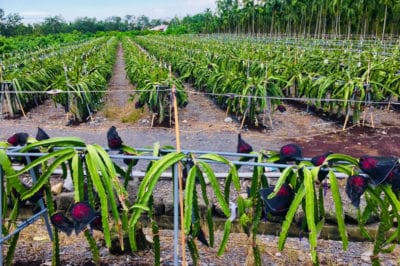Growing Dragon Fruit
If you live in USDA Zones 10 and 11, you can grow dragon fruit outdoors in your garden or in pots. The plant likes well-drained soil – amend clay with lots of humus and coarse builder’s sand. Bright indirect light is the best, as harsh sunlight can burn the plant. Water enough to keep the plant from wilting but remember over-watering may cause root rot.
Why a Trellis?
It might be helpful to think of dragon fruit as being similar to a tomato. The plants are more sprawling than true climbers. While they can be allowed to ramble on the ground, the fruits are easier to harvest and will usually ripen better if grown on a trellis. They are also less susceptible to insects and disease, and will take up much less room.
How Dragon Fruits Climb
Unlike other climbers, dragon fruit does not twine up a support and does not have tendrils or discs to grip a wall. What it does have is aerial roots that emerge from the joints in the stems. However, in the garden, these are insufficient for connecting the plant to a support system. Dragon fruits in a container or the garden need to be tied to the support.
Choosing a Trellis
When choosing a trellis, each has advantages and disadvantages:
- Plastic is inexpensive and won’t rot; may not be heavy enough for a mature dragon plant.
- Metal is more expensive than most materials but won’t rot and is very strong.
- Wire is unlikely to be able to hold the weight of the plant.
- Wood is sturdy, inexpensive and can be treated to resist rot.
Support for the Plant
It is critical to choose a trellis that can support the full weight of a dragon fruit. In the wild, the plant may grow up to 20 feet in length and can weigh several hundred pounds. Gardeners can manage the growth by pruning the plant. Commercial growers often use a single 4X4-inch wooden post to which they tie the plant and prune the top branches in an umbrella shape.
Attaching the Plant
Dragon fruit plants must be attached to the supporting structure. However, like most cacti, their stems are jointed and relatively easy to break. Training a single stem up some distance from the ground and securing it at multiple places with soft plastic or cloth ties offers a good solution. Don’t use wire as it can cut through the stems.
